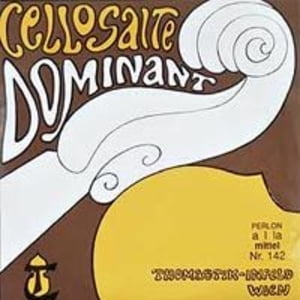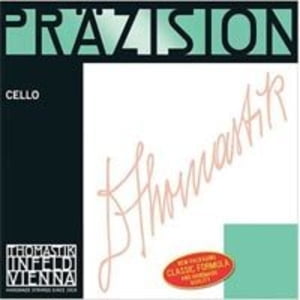5. String Types
A cello is a string instrument, but in contrast to a guitar, harp, mandolin etc. the strings are not plucked, rather they are ‘bowed’ with a string bow. Which is where they get their name. Unlike plucking, when you bow you are able to influence the tone, the simplest way to do this is to alter the speed and pressure of the bow.
The strings of a cello must meet many requirements as they are as important for sound production as any other part of the instrument. When bowed the strings begin to vibrate, the vibrations are transmitted to the resonator body, amplified there, and then emitted as sound. Specifically, the vibrations are transmitted via the bridge to the ceiling/front, then distributed through the sound post and bass bar to the entire body. The vibrations not only resonate through the body, but also through the fingerboard, neck, pegs and tailpiece. Because of this they all play a role in improving, or worsening, the sound produced.
If you read through the advertising claims of string manufacturers though you’ll get the impression that the strings alone are responsible for powerful tone, brilliant sound, large volume, dark timbre, etc. And while you can’t turn a cheap instrument into a master cello by changing the strings, they do play a very important role in the sound produced. The feel, voice quality and break-in time are also dependent on the type and quality of the strings.
An all-round string with a very short break-in time, optimum sound quality, good response and excellent tone stability doesn’t exist. More than 10 well known manufacturers currently compete in the market, meaning there are a lot of options. Each of them are continually producing ‘new and better’ strings to replace their old ones. Because of this the number of different strings available for cellos has become very large, making the ‘right’ choice may seem daunting. Even this guide will be no replacement for the trained eye of a professional instrument maker, as which string is most suitable can hardly be ascertained remotely. Often times different types of strings are mixed together even and in extreme cases, four different strings are used.
If you look around on the internet you’ll soon find that there are cellists who favor certain string combinations and that others find these combinations absolutely crazy. The reason for this is that each cello is an individual piece with its own resonation characteristics, meaning the strings that are a ‘perfect’ fit will probably only be found through intensive work. And the results of that work cannot simply be carried over to another instrument. Because of this it isn’t possible for this guide to answer which strings will be perfect for your instrument, they simply vary too much. We are only able to provide an overview of the different string types and their notable characteristics so that you can orient yourself. Sometimes though you just have to take a risk and try something new.
An important tip: If you purchase a new cello it will generally come with the appropriate strings, however, you can usually get more out of the instrument with higher-quality strings. Please don't hesitate to contact us for a suggestion.
To provide a starting point we've described the three most common types: These are the gut, plastic and steel strings. The type name alludes to the material from which the core of the strings is built. From the outside strings often look very similar because they are wrapped in thin layer of metal wire.
Gut Strings
Traditionally strings for cellos and other string instruments were made from the intestines of ungulates (animals with hooves), mostly sheep from barren and dry areas. The intestines were cut into strings, spun, dried and finally polished. These bare gut strings still exist today but are only used for the stringing of historical baroque instruments and for the authentic performance practice "Alter Musik". Most gut strings on the market today are wound in metal as previously mentioned. Winding the core of the string increases its mass, making the string heavier and deeper sounding. Without this metal wrap the string would have to be much thicker for certain pitches. To put it another way: Wrapping the strings allows them to be much thinner, without affecting elasticity or playability. The type of wrap also significantly affects the sound properties (see below).
Gut strings generally have a relatively soft and warm sound, but are very susceptible to changes in temperature and humidity; They have the habit of pulling water from the air and will start to swell, reducing tension. The break-in period, that is the time it takes for the strings to hold a tone, can take one to three days. Their playing life is also the most limited, professionals may change their strings every one to two months, while for normal players they last about a year. The advantage is that gut strings have a powerful tone, are pleasant to the touch, have a higher natural elasticity and are more responsive. They are usually wrapped in aluminum or silver and, as with the other types of strings, there are different strengths e.g. "soft, medium, strong" or "dolce, medium, forte".
Strings with a Plastic Core

The term ‘plastic strings’ is a bit misleading since bare plastic strings are not used on string instruments like cellos. Purely synthetic strings are used on classical guitars and ukuleles. Like gut strings though, the plastic portion is only the core, which is then wrapped with a metal. Several different materials may be used for this, and, similar to gut strings, this affects the thickness of the string and its sound properties. For example, silver is usually used for the lower strings to provide a stronger and warmer tone. But there are also differences in the plastic core itself, it may be made from nylon, perlon or polyester, to name a few. A plastic string has similarities to a gut string as far as tone and performance (though they cannot 100% recreate the sound of the natural material). Strings with a plastic core have come far enough though that they are used by both beginners and virtuosos. They are also ideal for a wide variety of music styles and offer a number of advantages over gut strings: They keep their tone very well and are not affected by temperature and humidity changes. They have a sound that is usually described as round, clear, soft and having rich overtones. From a fingering standpoint they are relatively soft and sound modulation is relatively easy. The break-in time varies though and depends entirely on the string type.
Steel Strings
Steel strings are more well known from the world of guitars and similar instruments and their use with stringed instruments sometimes has negative connotations. Something which is partly justified but not always true. Steel strings for string instruments have the same characteristics which make them so desirable in plucked instruments: they vibrate for a long time, that is they hold their sound. But this is exactly what you want to avoid with stringed instruments and is why cheap steel strings have such an unpleasant, metallic sound. The reverberation of the strings can be suppressed by a targeted damping of the steel core. This is achieved by wrapping them in more metal or by adding an underlying layer of braided silk or plastic threads. The steel string core is made of crucible cast steel, which is drawn over stone or diamonds making it thinner and thinner but also condensing it.
The advantage of the steel strings, when properly wrapped, is their reverberation time and long playing life. Making them very popular with beginners and for teaching. They are characterized by a powerful sound which unfortunately for cheaper models is often rather hard and metallic sounding. Simple and inexpensive steel strings have a full steel core, while higher quality strings have a wound steel (cable) or fine steel core. Wound steel core strings have a powerful, soft and sonorous sound, they are often used for both the viola and cello. Fine wire steel core strings are a bit softer and thus more tangible, and with their powerful, round and balanced sound, meet higher standards of play than the other types.
Different Strengths
Strings are offered in different strengths as mentioned, although the strengths from different manufacturers are not necessarily comparable. Common names for the strengths are: "soft, medium, strong", "dolce, medium, forte" or "light, medium, heavy". A thinner string is closest to the ‘ideal’ string from a vibrational standpoint as they provide a good tone and very rich overtones but the volume of the sound produced is rather low due to the low mass. For a stronger string, the tone may be worse but the sound is fuller. Stronger strings are recommended for instruments with a lower bridge, with thicker walls and for those that have a high ceiling curvature. You can test this out with the strings that are set up your instrument by down tuning a bit. If you like the sound better then you can put thinner or lighter strings on. If not then stronger strings will probably sound better. If you don’t have a clear idea of what sound is needed yet then just go with medium strength strings.
Wrapping
Finally, a few words about the metal wound around the core of string, that is the wrapping. Wrapping increases the mass and the higher the mass, the deeper the string sounds. Without wrapping it would be nearly impossible to make the thick, heavy strings needed for larger instruments. The wrapping can be made up of one or more layers of round or flat wire. If using round wire, the string will be sanded after being wound. A variety of different metals are used including steel, chrome steel, tungsten, silver, aluminum and titanium. Usually there is an intermediate layer of braided silk or plastic threads between the core and wrapping. This helps the wrapping to hold better and the core receives a form of internal damping. With aluminum, which is very light, you can make very thick strings which are relatively inexpensive but have the disadvantage of blackening fingers (sweat is acidic!) and otherwise wearing out quickly. Aluminum sounds bright and is more likely to be used on the higher strings. Silver is heavier, meaning strings made with it are thin and most suitable for the fourth string. Silver is only used for the upper cover layer and is often mixed with nickel. Titanium is an expensive, lightweight metal that is mainly used for the thinnest string. The disadvantage is that it causes higher wear on the instrument and causes the ligaments of the bow to loosen as well. Tungsten is more or less neutral but allows for thinner strings due to its weight. If chromium is used it is usually as an alloy (chrome steel). Nickel in pure form is rarely used in stringed instruments, but is often found in alloys as mentioned. So if you have a nickel allergy you should look for strings specifically labeled as ‘nickel free’.




